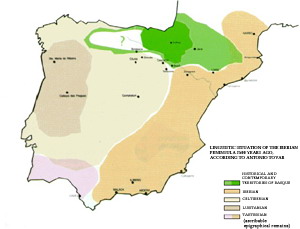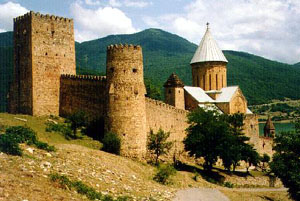
According to some linguists, Euskara is related to the Caucasian languages and especially to Georgian and Dagestani, from a grammatical point of view. They share some features like being agglutinative (3), ergative (4) languages and with the same declension system.
This relationship is not totally established since we do not have yet the Proto-Caucasian language (which would mean the origin of the current languages of the Caucasus) in order to make an exhaustive comparison with Proto-Euskara. This might solve the question about if all these languages took part of the same linguistic group in a remote past. Although the development of Proto-Euskara (or Euskara previous to the arrival of the Romans) is well advanced, we face many problems regarding the Caucasus: while the southern Caucasian languages (Dagestani and Georgian among others)  show clearly that they take part of a same linguistic group, the northern languages are very different among them and even with regard to the southern ones, what complicates the development of the Proto-Caucasian language.
show clearly that they take part of a same linguistic group, the northern languages are very different among them and even with regard to the southern ones, what complicates the development of the Proto-Caucasian language.
The Basque-Caucasian theory that holds a common origin of the Basques and the Caucasian peoples, explains two hypotheses regarding the migration starting point. The first and oldest one considers that the Caucasians migrated westwards to the Pyrenean area during remote ages, what would mean that the Basques are descendants of the Caucasian immigrants. The second and most recent hypothesis, which is based on studies in archaeogenetics, supports a Proto-Basque expansion throughout Europe that took place after the last Ice Age and that started in the region between the current south of France and north of Spain. As a result of this, the Caucasians would be the descendants of the Proto-Basques that migrated to the Caucasus.
As kindly indicated by Prof Peter Forster to this web site (he was responsible for the research in archaeogenetics that was carried out by the Cambridge University, which points to a Proto-Basque expansion in Europe after the last Ice Age), the Caucasians are much more diverse than the Basques, so that it is unlikely to find a clear relationship among them. However, the study is waiting for more genetic information from Eastern Europe, so that a definitive answer to this supposed common origin can be given.
(3) Agglutinative Language: each word contains several 'stuck' components and in turn, each one of them has its own meaning. The union of those components is made in such a way that they keep their form, that is to say, without any variation, what allows the word to be easily segmented. Let us have a look at the following example in Euskara, which is an agglutinative language: the term 'gizon' means 'man'. The component '-aren' means 'of the' and the particle '-a' is the article of the word under construction. The resulting word is 'gizonarena', that means '(the thing) of the man'. As we can see, each segment of the word sticks to the rest, they agglutina te without suffering any change what makes easier the word segmentation in its components with their meanings.
te without suffering any change what makes easier the word segmentation in its components with their meanings.
(4) Ergativity of Euskara: the Basque language distinguish grammatically between the intransitive subject and the transitive or active subject. The following examples show how Euskara uses the ergative mark or active mark in the transitive clauses, which consists of a final '-k':
Gizona etorri da ....[the man has come]: the instransitive subject does not receive the mark
Gizona ikusi du.......[(she/he) has seen the man]: the object of the transitive verb does not receive a mark.
Gizonak ikusi du.....[the man has seen]: the transitive subject receives the mark '-k'.
The behaviour of Euskara, that is, the ergative construction, is exceptional in the world and especially in this area of the world. Almost all of the Caucasian languages use this kind of construction as well, although each one uses it in a differentiated way. This is the peculiar typological feature of the so-called 'ergative languages'.
|
Georgian |
Basque |
Spanish |
English |
|
Zari |
Zara, Otzara |
Cesto |
Basket |
|
Gw |
Gu |
Nosotros |
We |
|
Gvari |
Guraso |
Los padres |
Parents
(Both terms, Georgian and Basque, come from their respective personal pronoun 'we')
|
|
Ezer |
Eder |
Hermoso |
Beautiful |
The Basque verb agrees with the subject (like in Castilian), and also with both direct and indirect objects. The verbal form changes depending on the number of things (direct object) and people (indirect object) involved. That is, the verb varies according to the person and the number of the subject as well as the direct and indirect objects.
In the following example, the auxiliary verb 'dizkiozu' means: 'you have ... them to (him/her)'. The letters '-zki' indicate that there are several things involved (them); the vowel '-o' means that the beneficiary of the action is the third-person singular (him/her) and finally, the letters '-zu' indicate that the subject is the second-person singular (you).
This interesting way of verbal conjugation is only shown in the northwestern and southern Caucasian languages and in Euskara. There is another similarity between Georgian and Euskara: the use of the vigesimal numeral system, where even the location of each figure components is the same. However, the Caucasian phonetics is totally different from the Basque one since its number of consonants is much higher than in Euskara.
Share this page!


 te without suffering any change what makes easier the word segmentation in its components with their meanings.
te without suffering any change what makes easier the word segmentation in its components with their meanings.